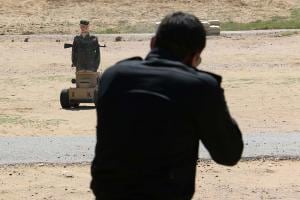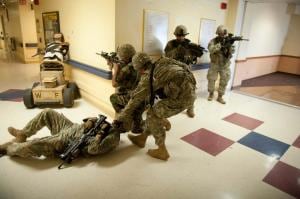LAS VEGAS ― Upright, wheeled, semi-autonomous robots rolled their way across a dusty range here as a mock team of shooters mounted up for their attack.
The robots took their places behind cardboard cover and began their own version of an ambush setup. The human team sped into the zone on two all-terrain vehicles and engaged. Through programming, the robots know when they’re being shot at, from where and if one of their compatriots has been hit.
They react accordingly. They seek cover, use obstacle avoidance software to keep from running into each other or running over the shooter, should they close the distance.
The robots were on display for a shooting scenario at the Sig Sauer range day, part of the annual Shooting, Hunting, Outdoor Trade Show.
And an estimated 6,000 Marines over the past year have had a chance to get some more realistic target practice than what they usually see in paper targets and specified, known distances.

Ralph Petroff, president of the North America branch of Marathon Targets, touts his product as a way to make century-old ranges modern without rebuilding the whole enterprise.
The robots effect goes beyond large fields with open terrain. They can be set up in urban environments and programmed for patterns of movement and move at differing speeds to mimic large crowds in which friendly and unfriendly actors are mixed together.
Retired Marine Col. Walt Yates, formerly head of Training Systems at Marine Corps Systems Command, now works as a consultant for Marathon. He noted that the Corps has been looking for a better way to do mobile shooting for a decade.
The Marathon robots are robust, Petroff said they can withstand calibers up to .338mm range, which packs more punch than all but the .50 caliber in the current service branches’ arsenals.

The company has received an extension of a few months for further evaluation after the yearlong study recently wrapped up, Petroff said.
The study ran from November 2017 through the end of 2018 and took place with Marines at Twentynine Palms, California; Quantico, Virginia; and Camp Lejeune, North Carolina.
Todd South has written about crime, courts, government and the military for multiple publications since 2004 and was named a 2014 Pulitzer finalist for a co-written project on witness intimidation. Todd is a Marine veteran of the Iraq War.




